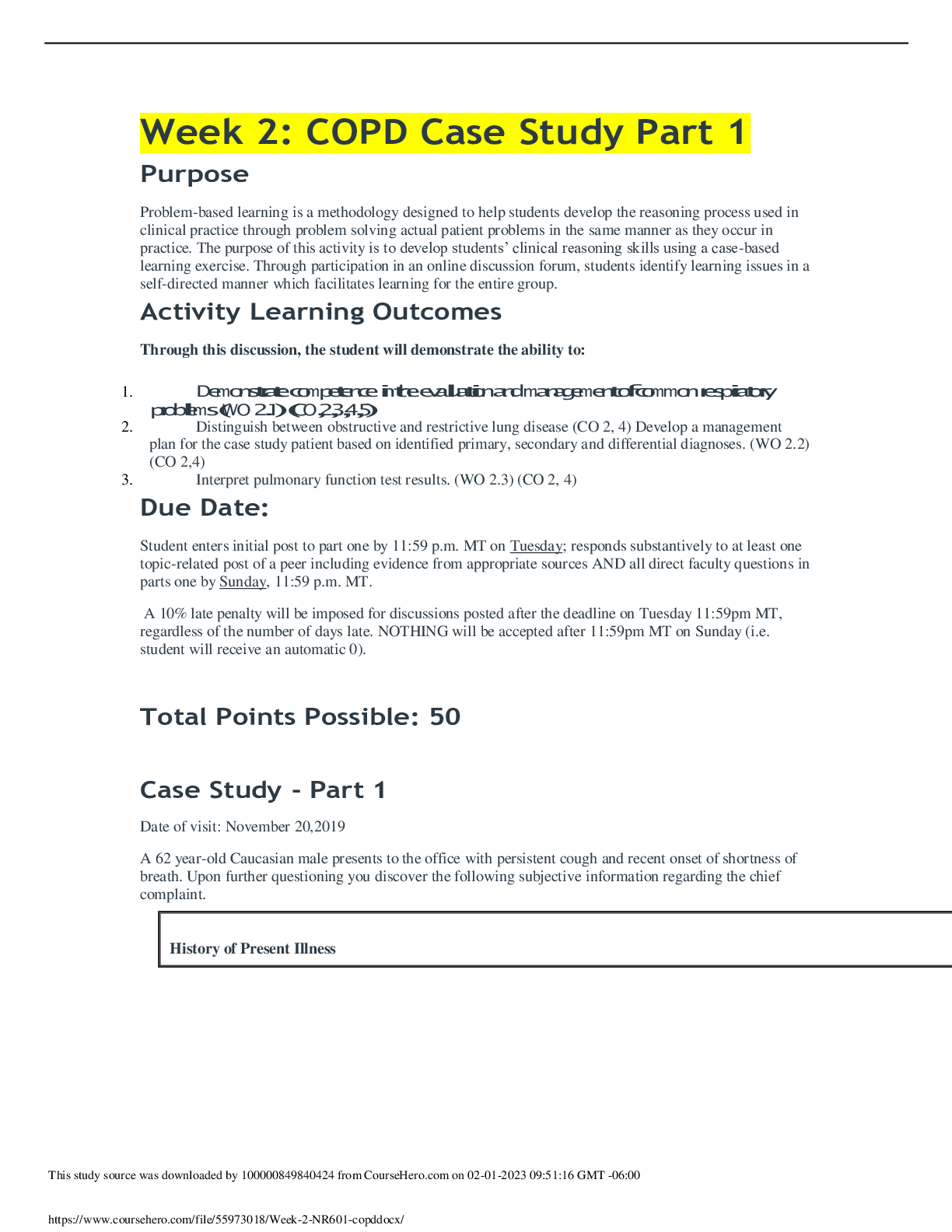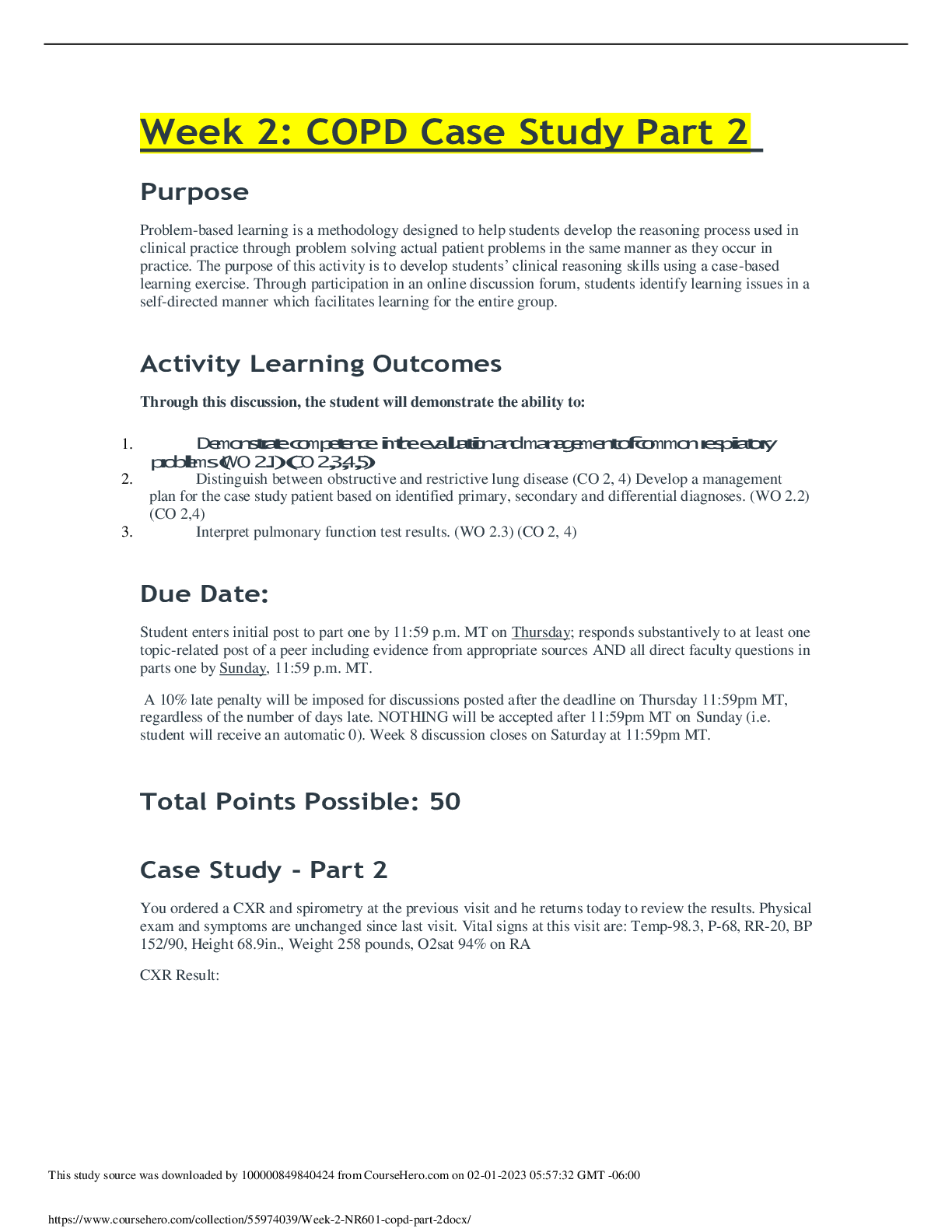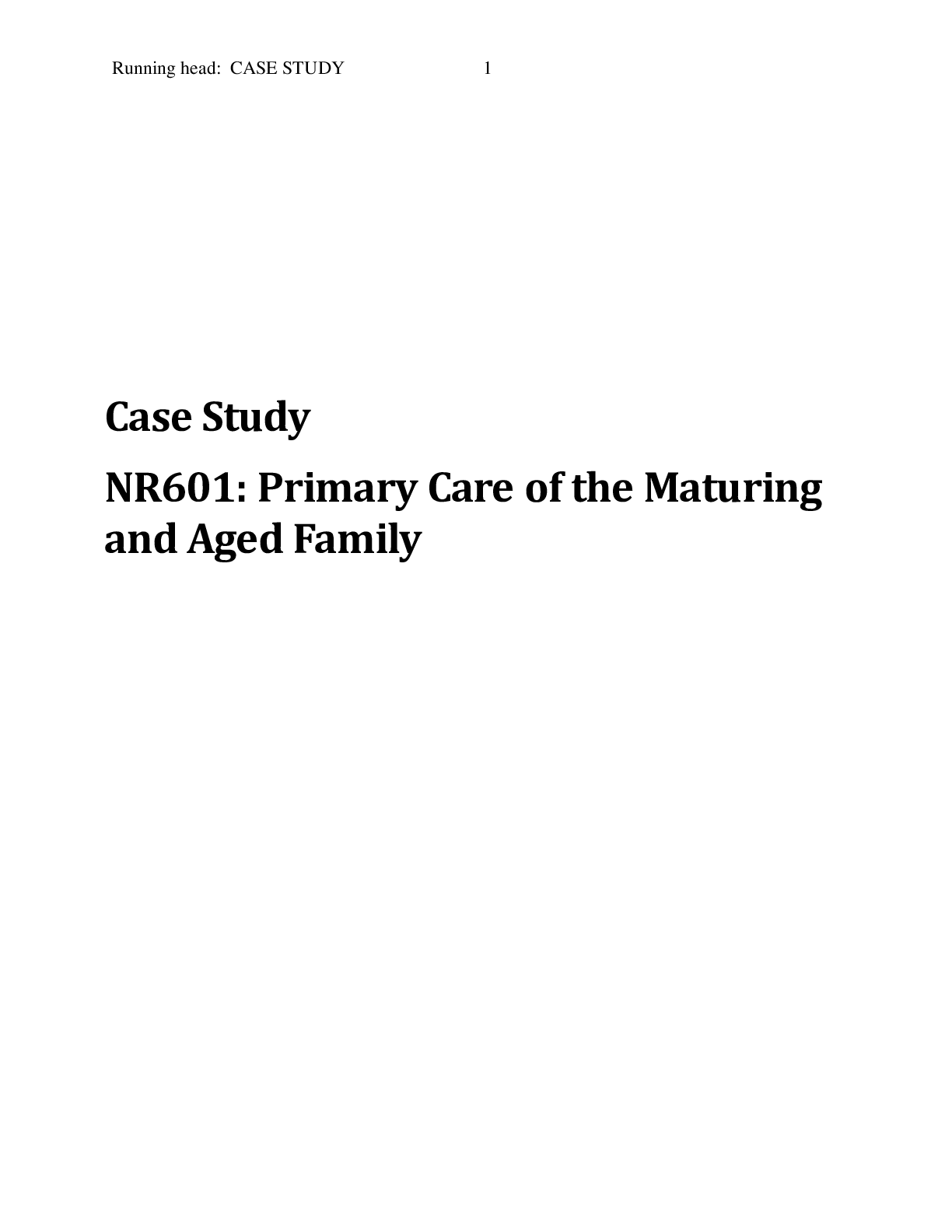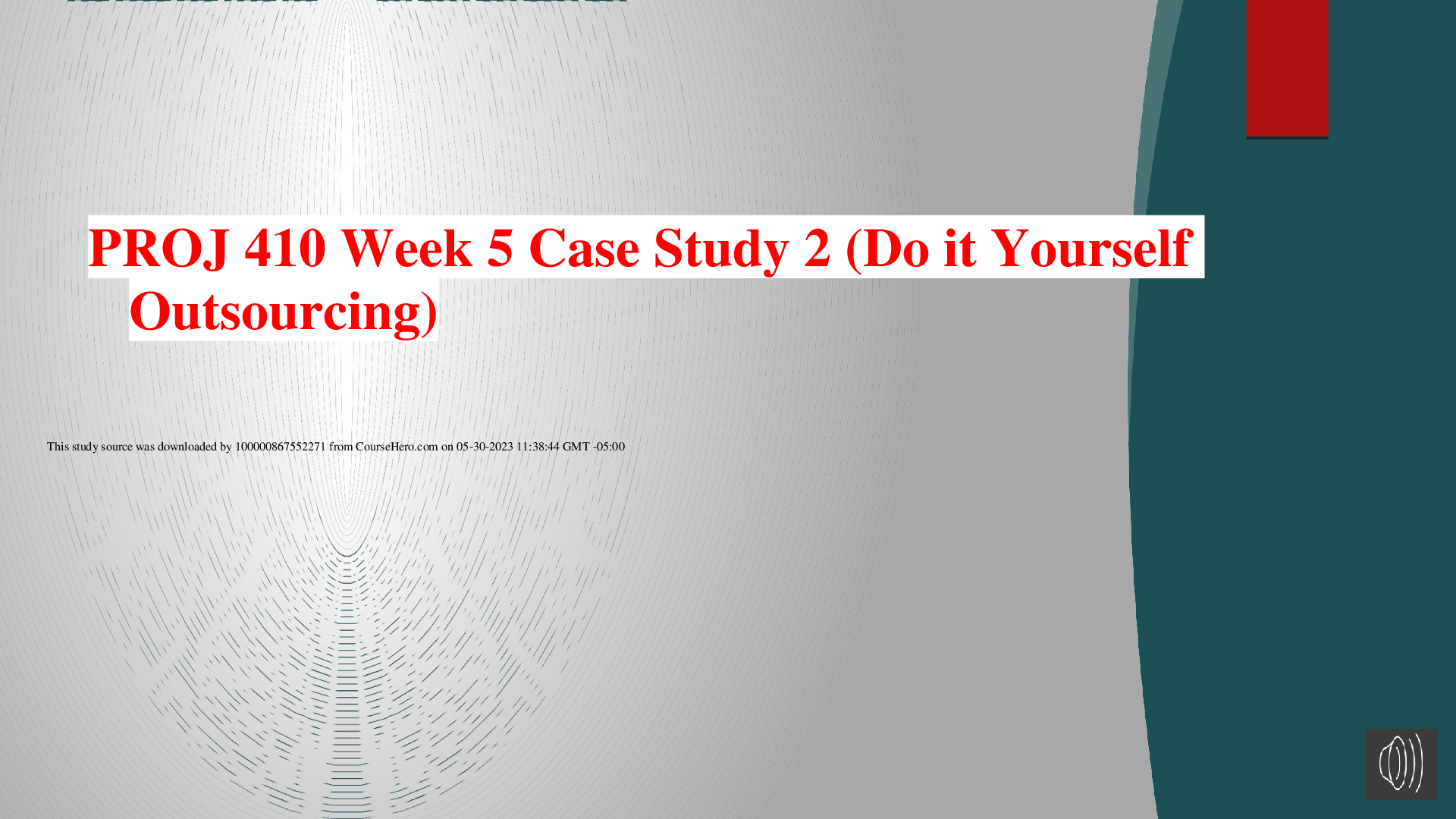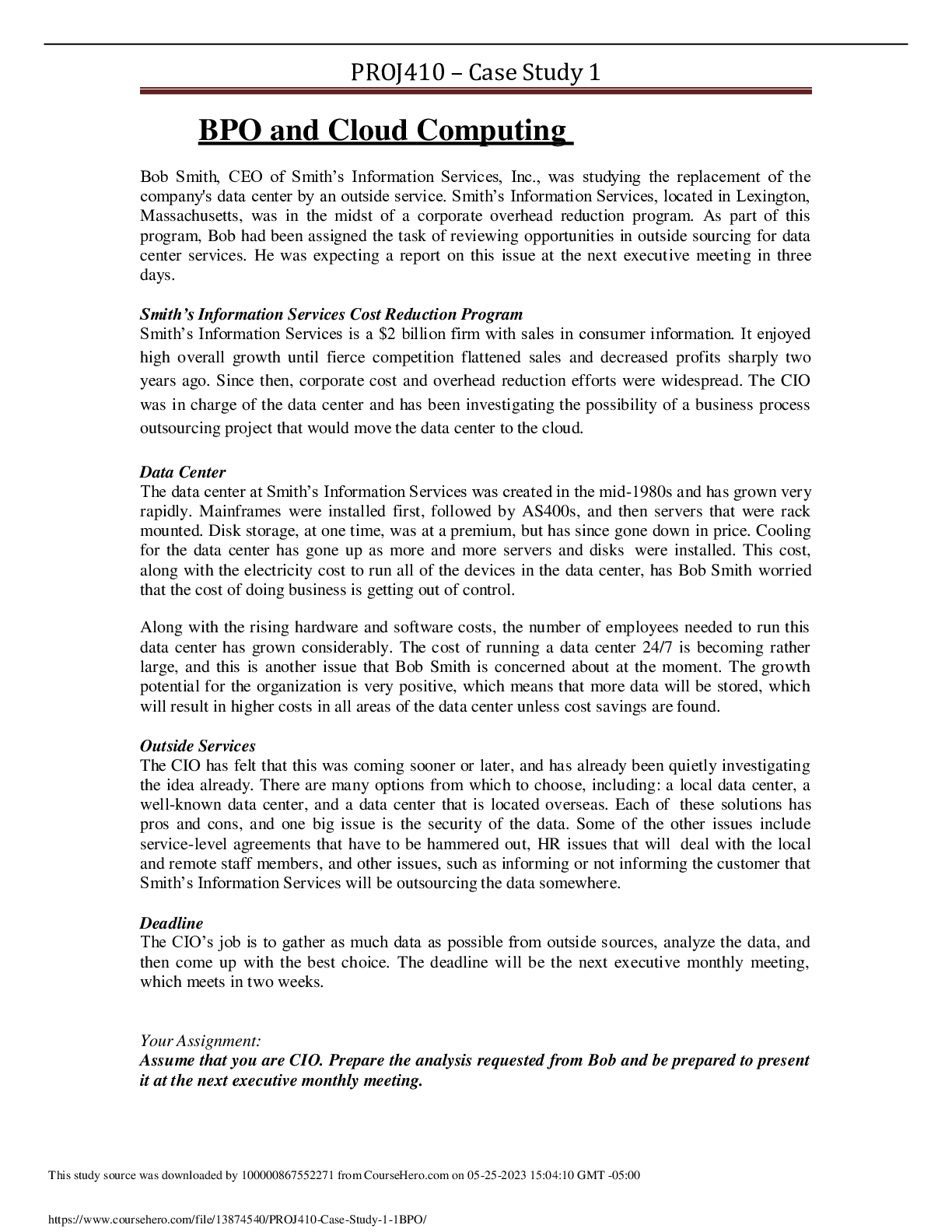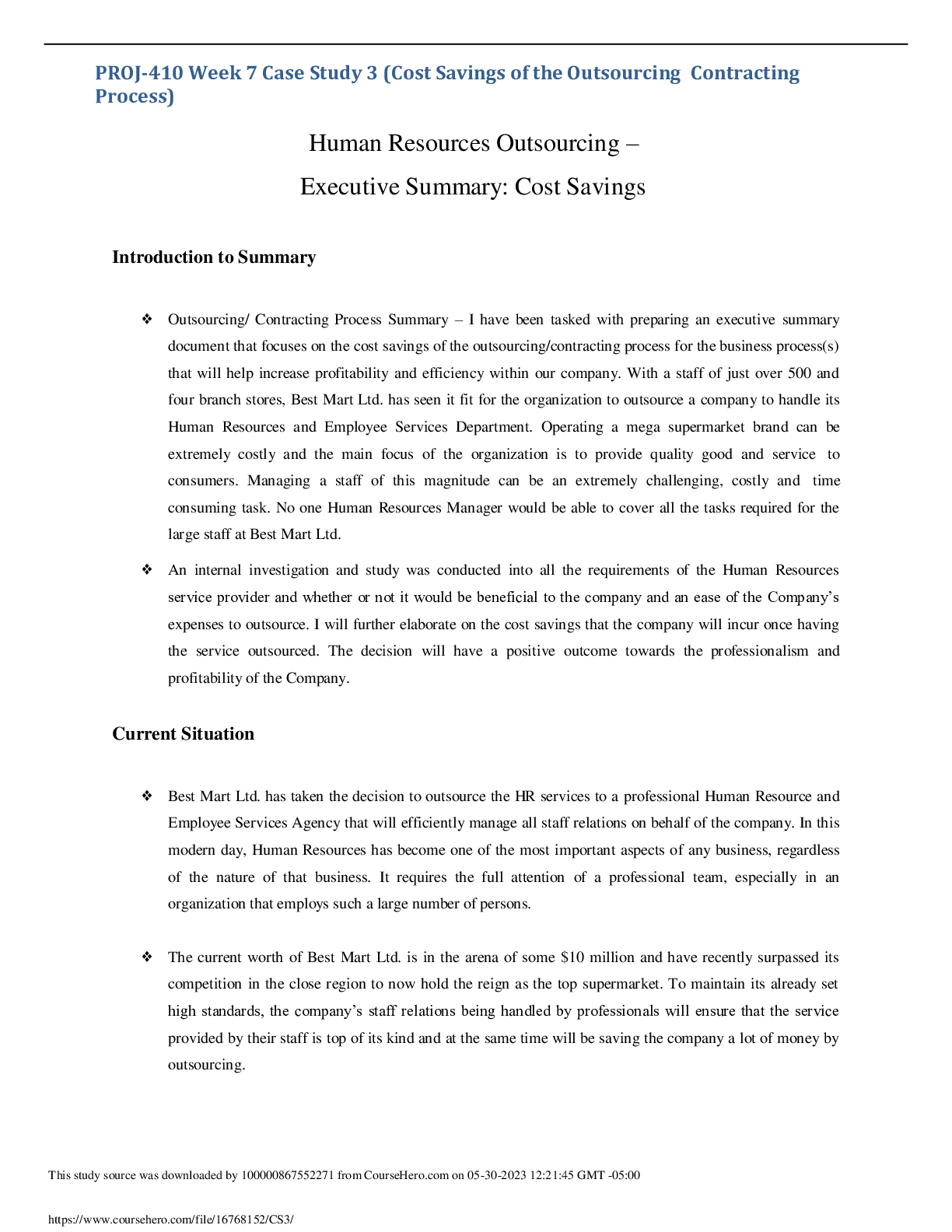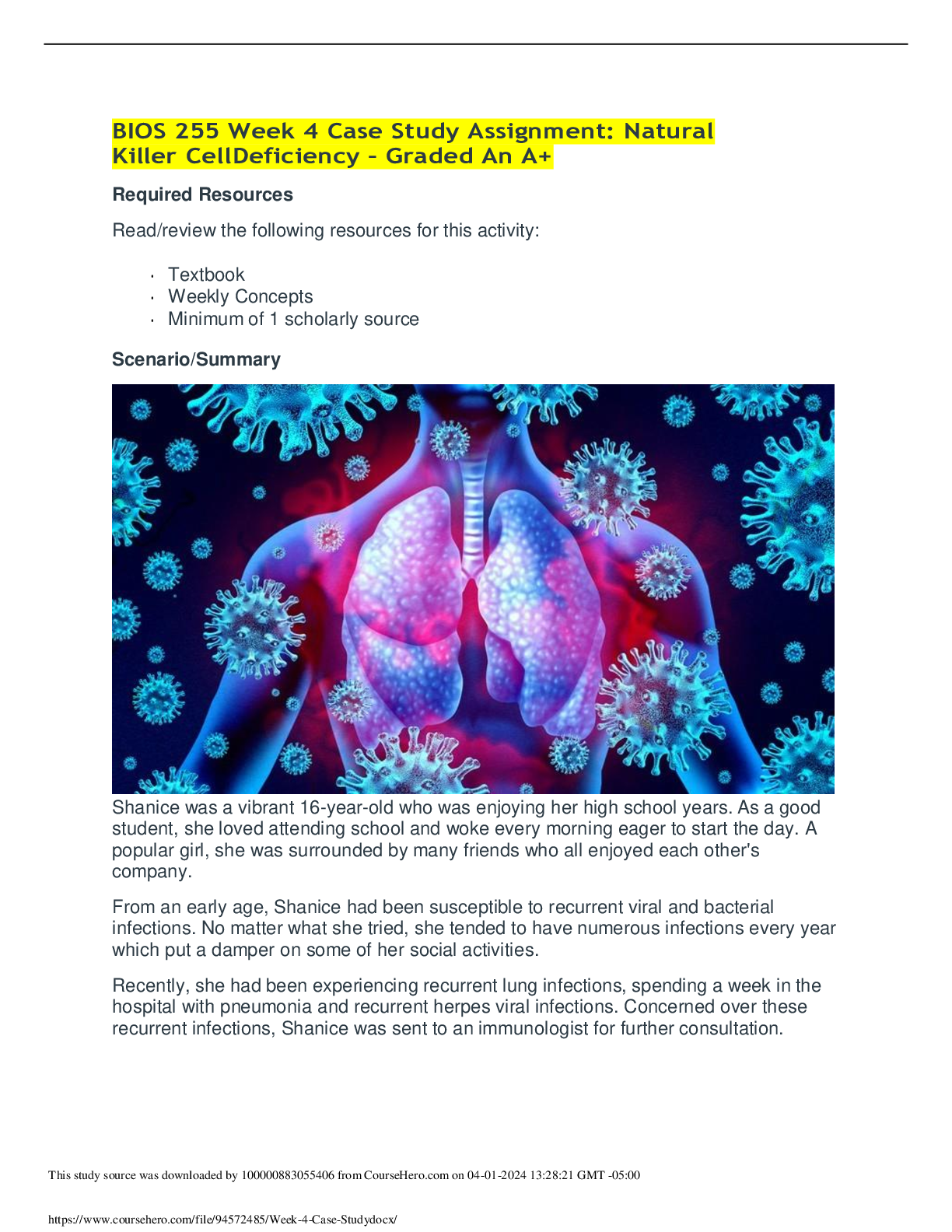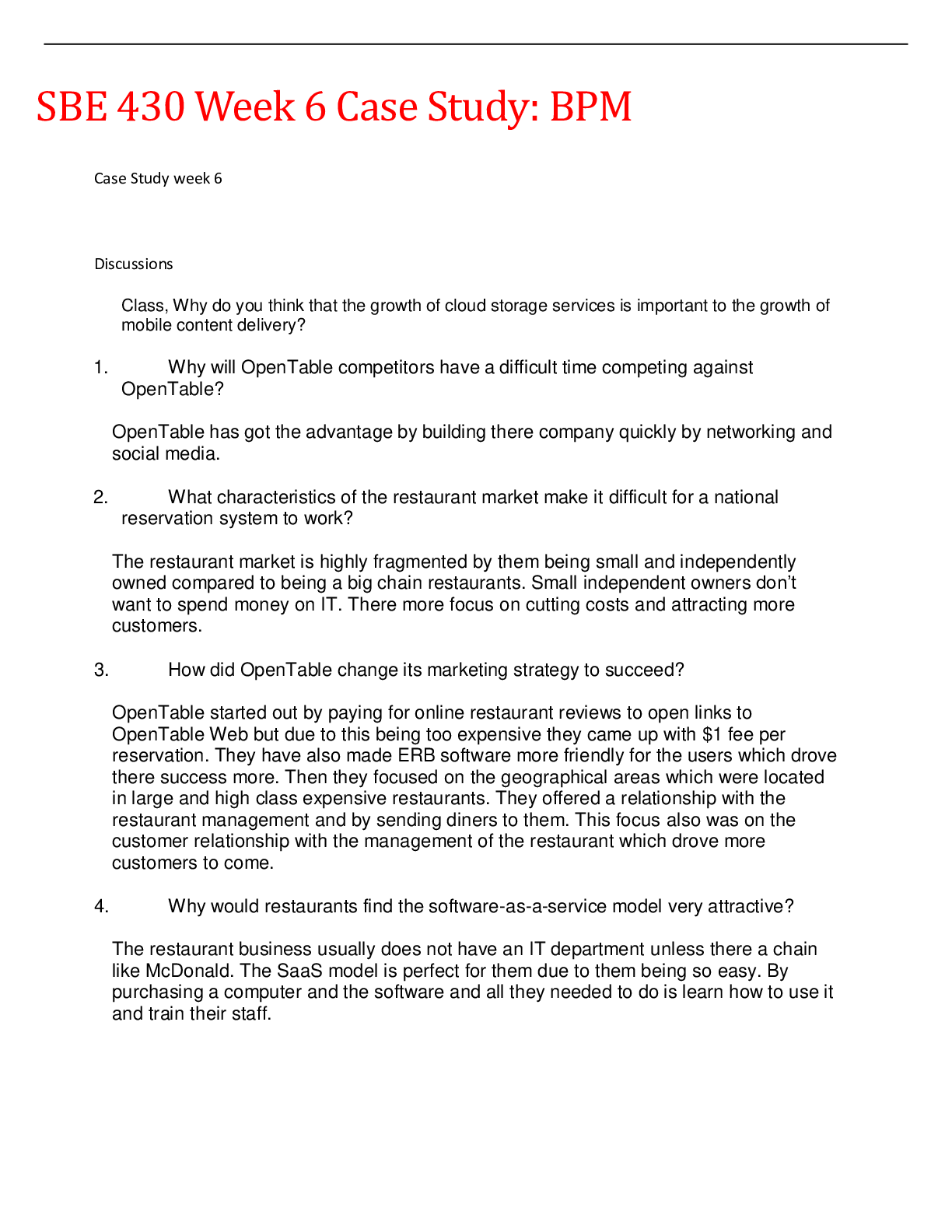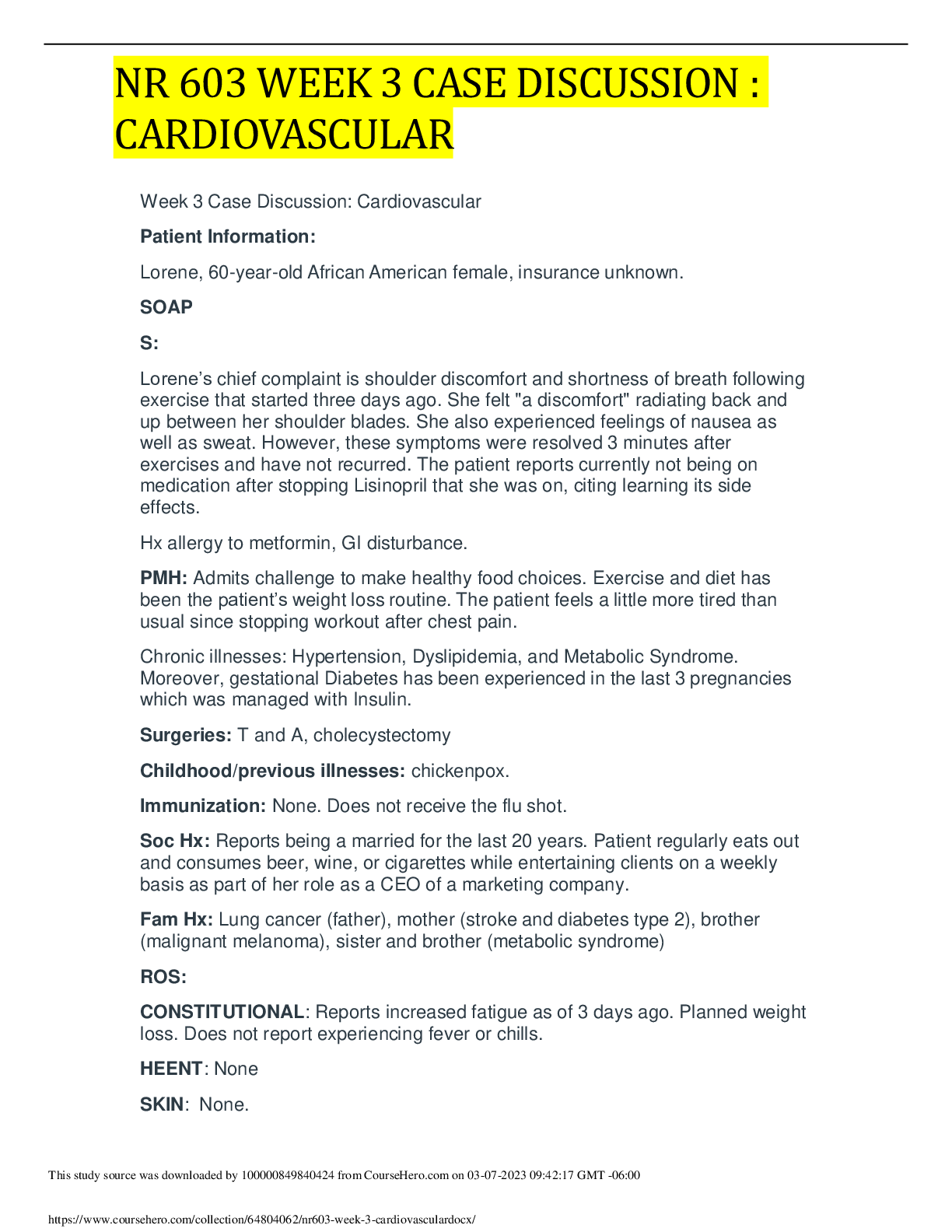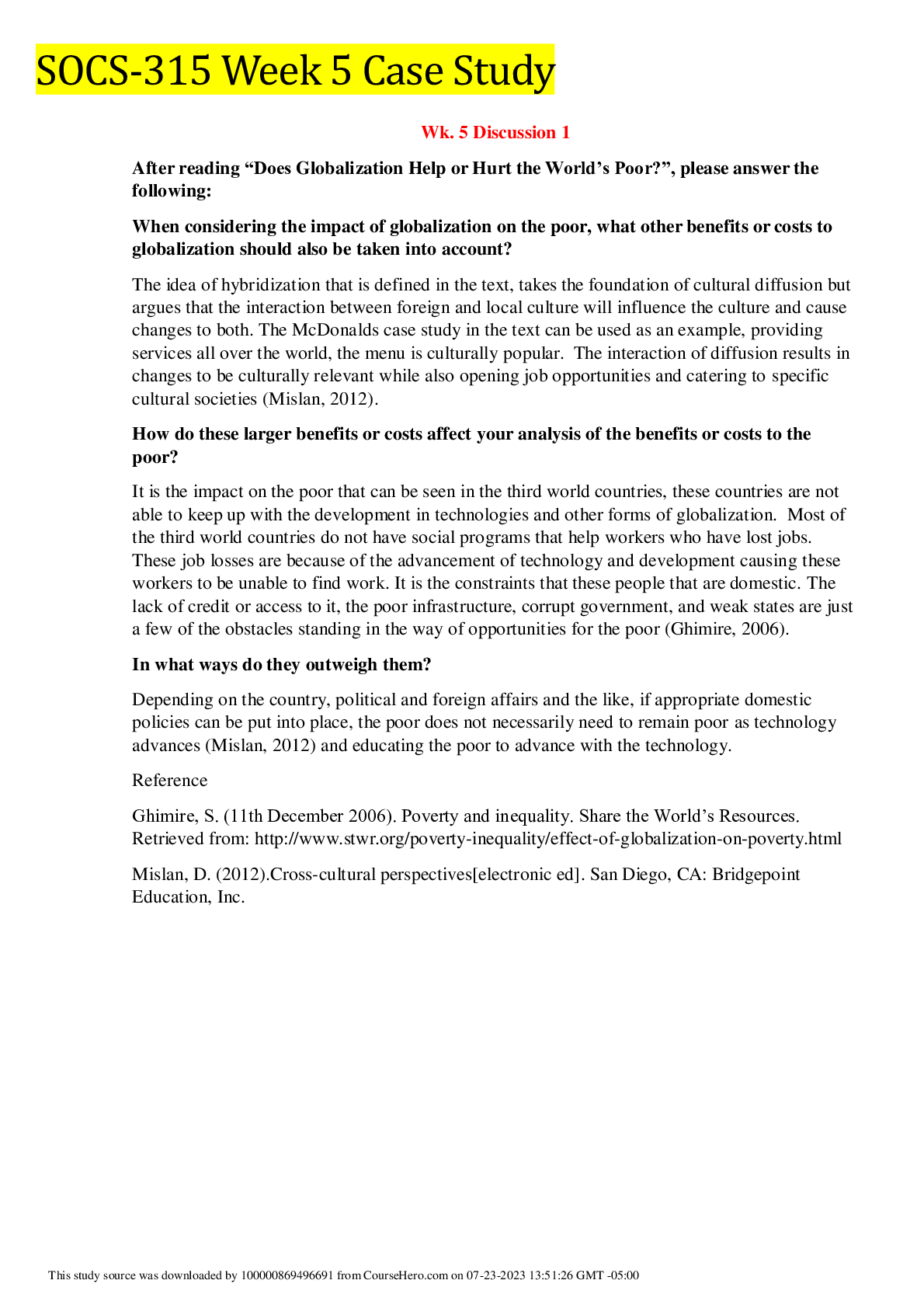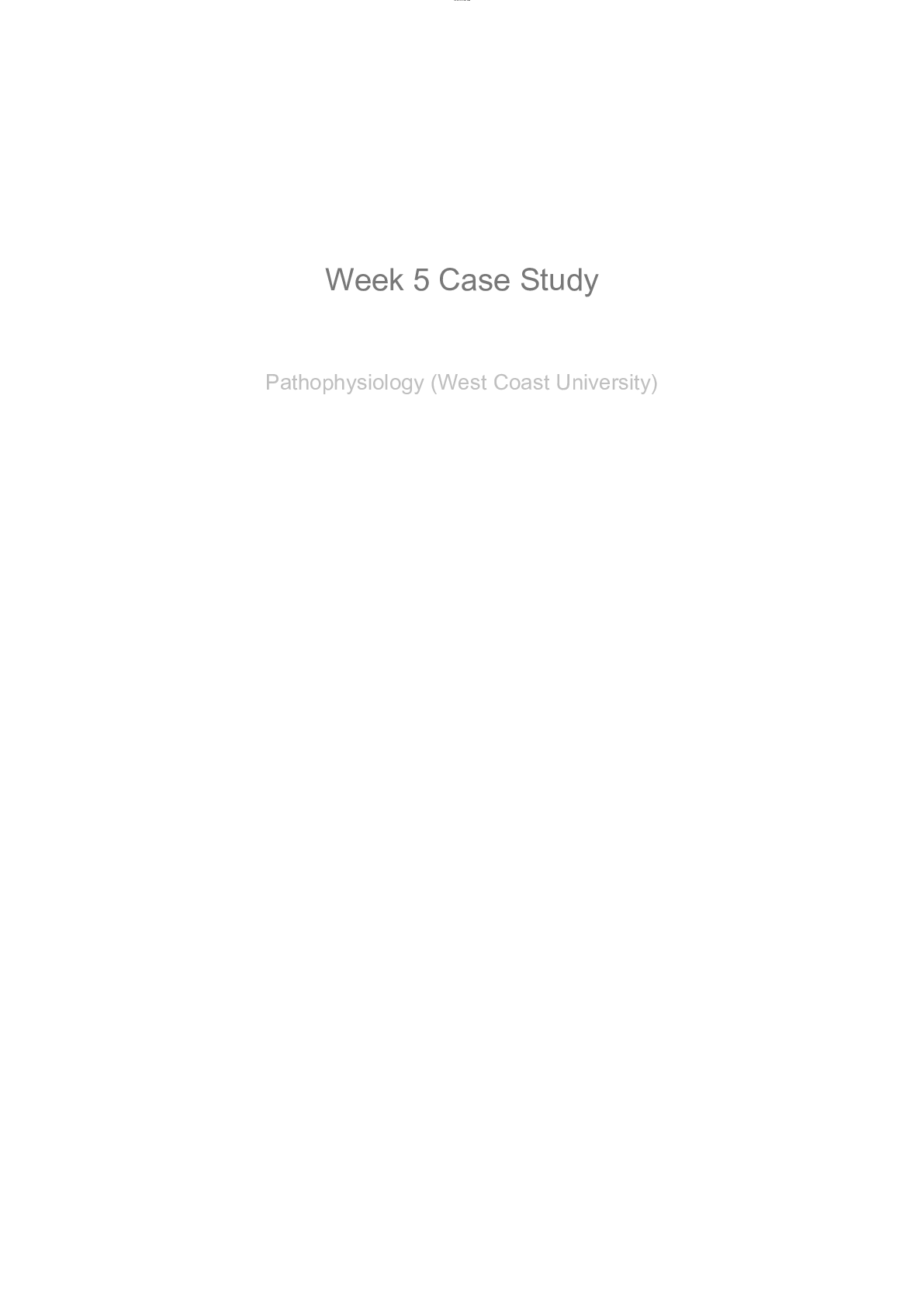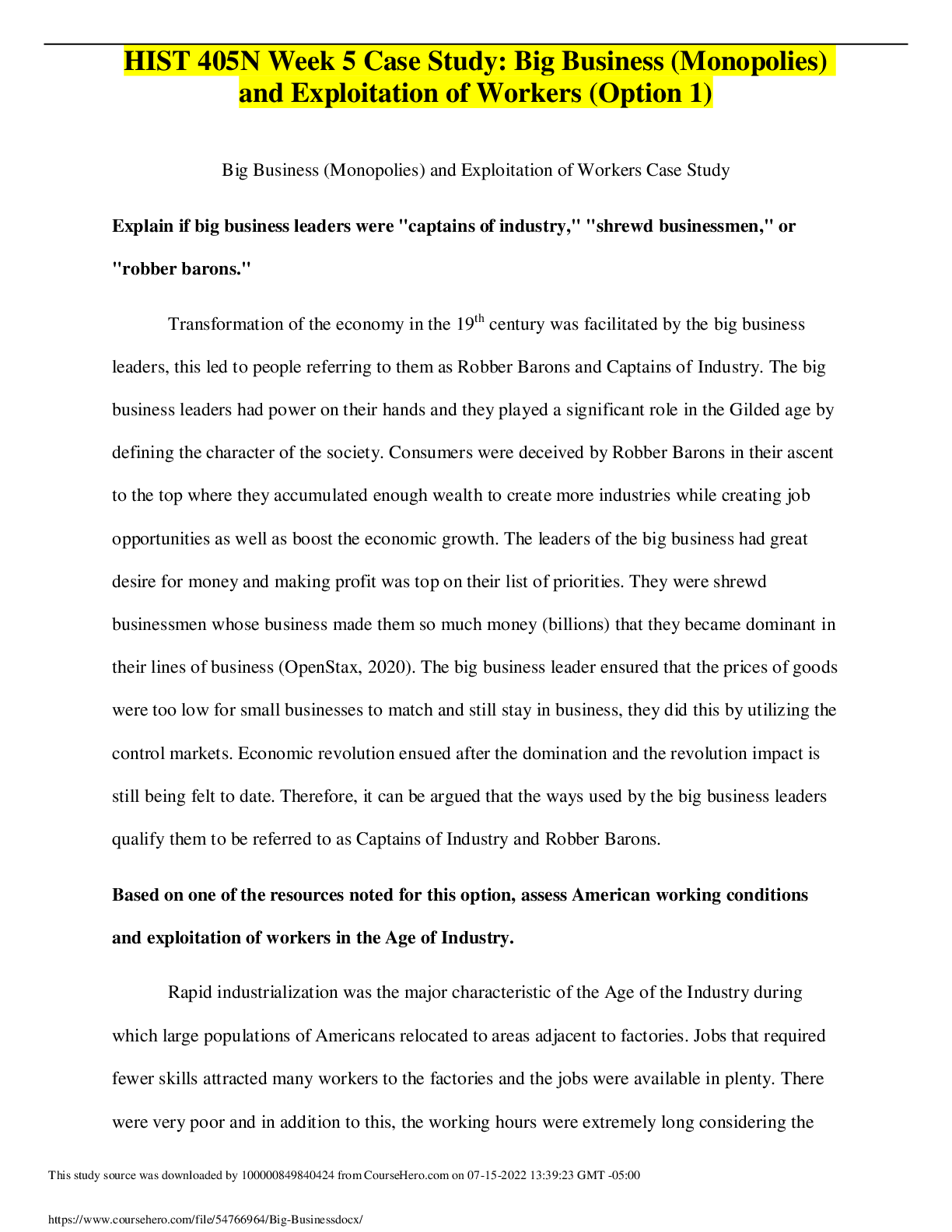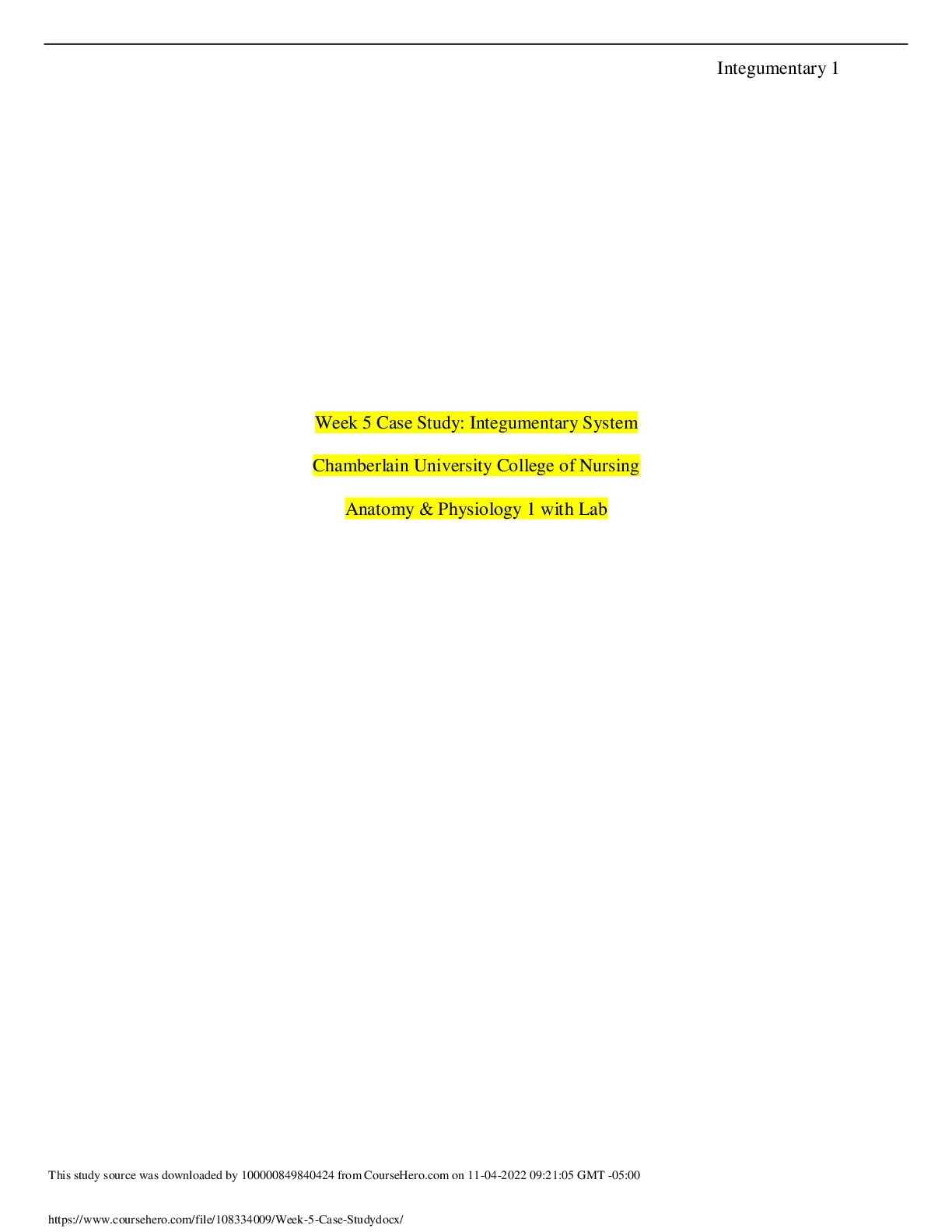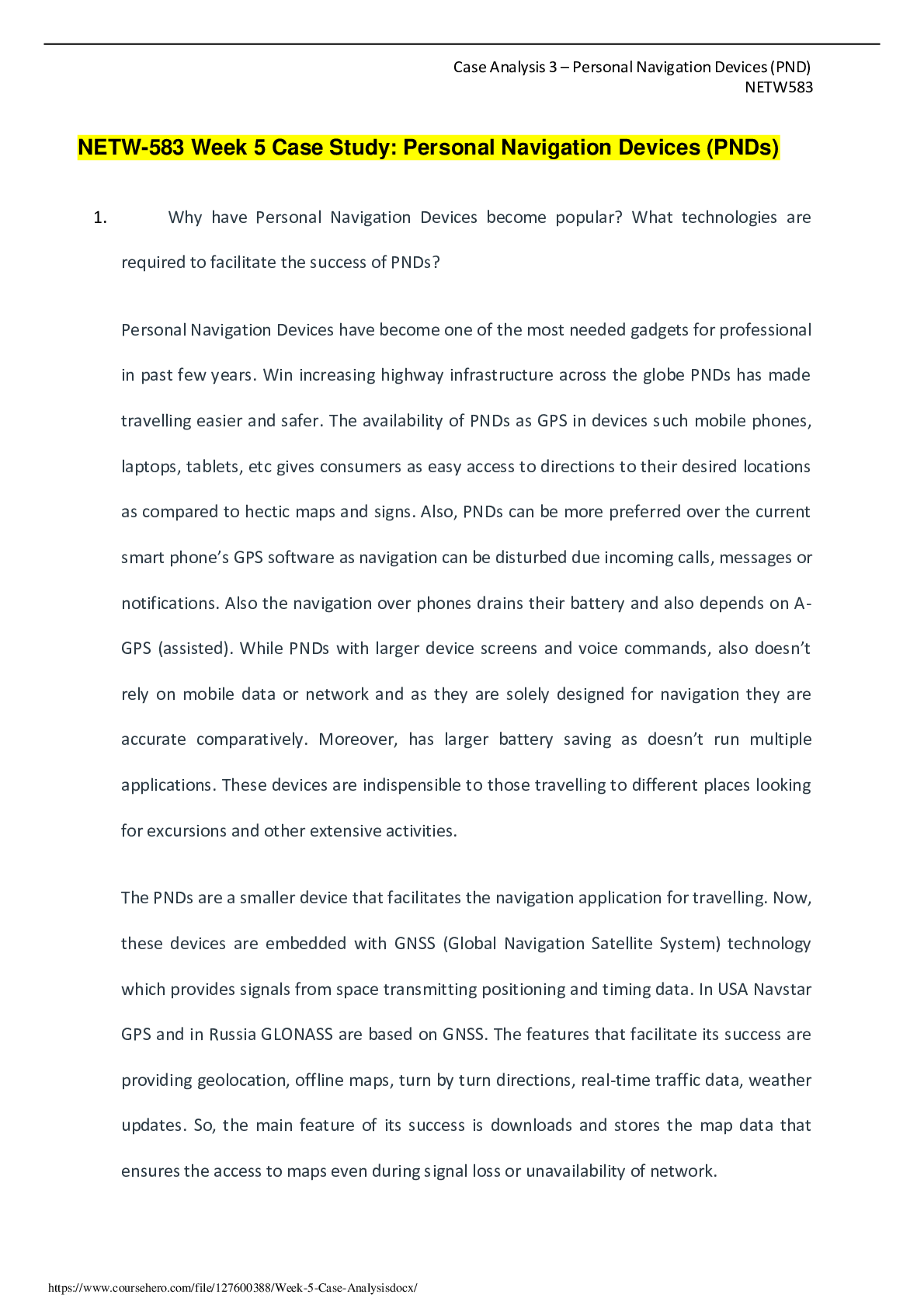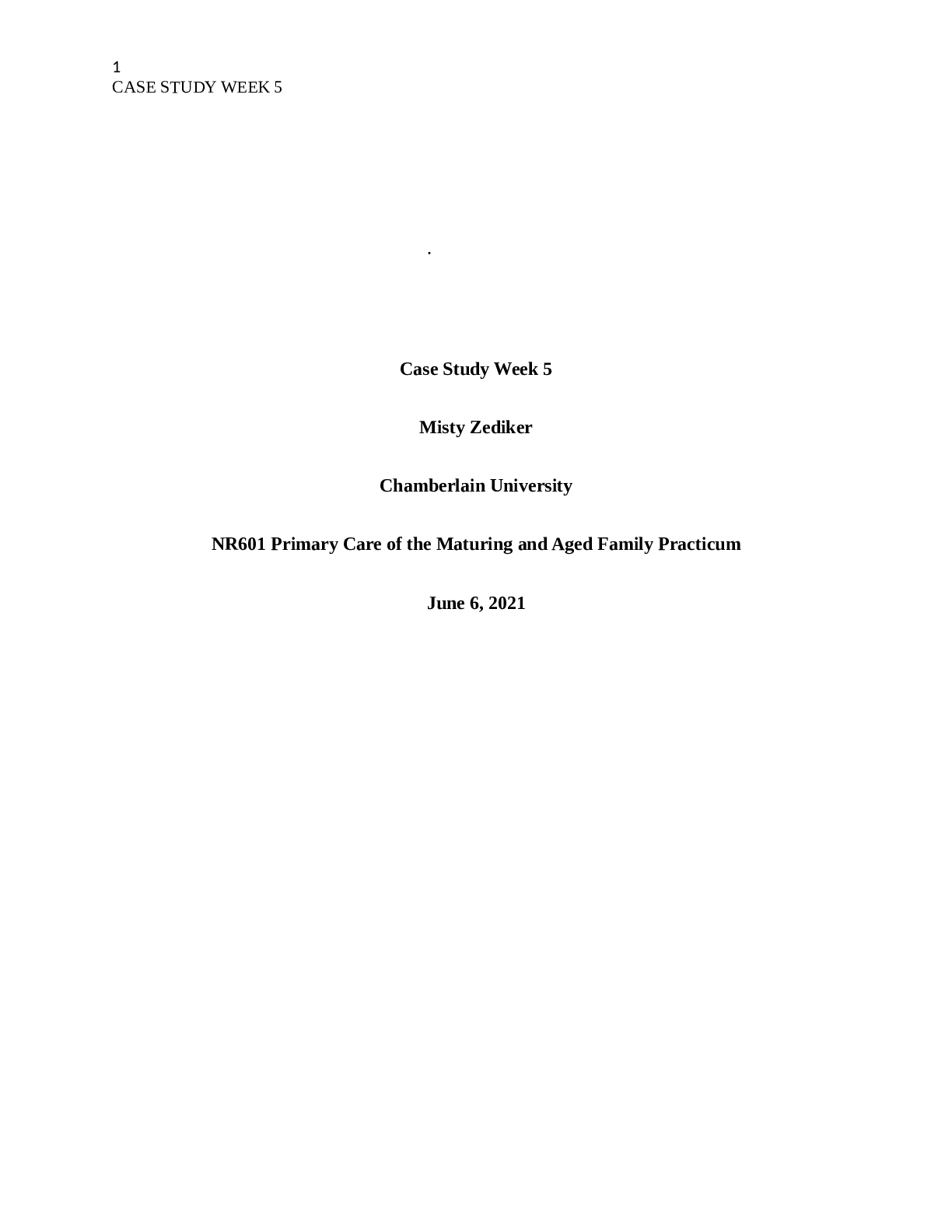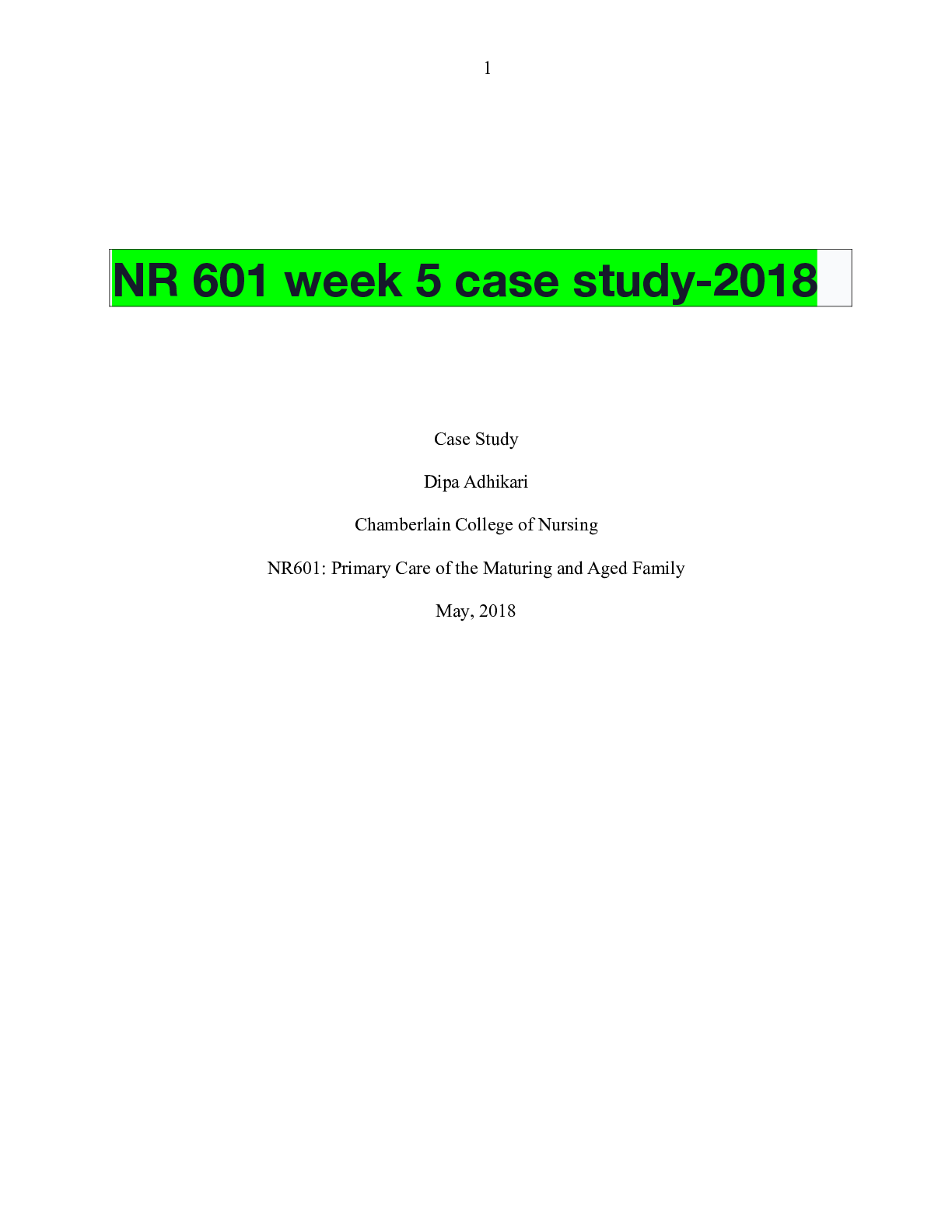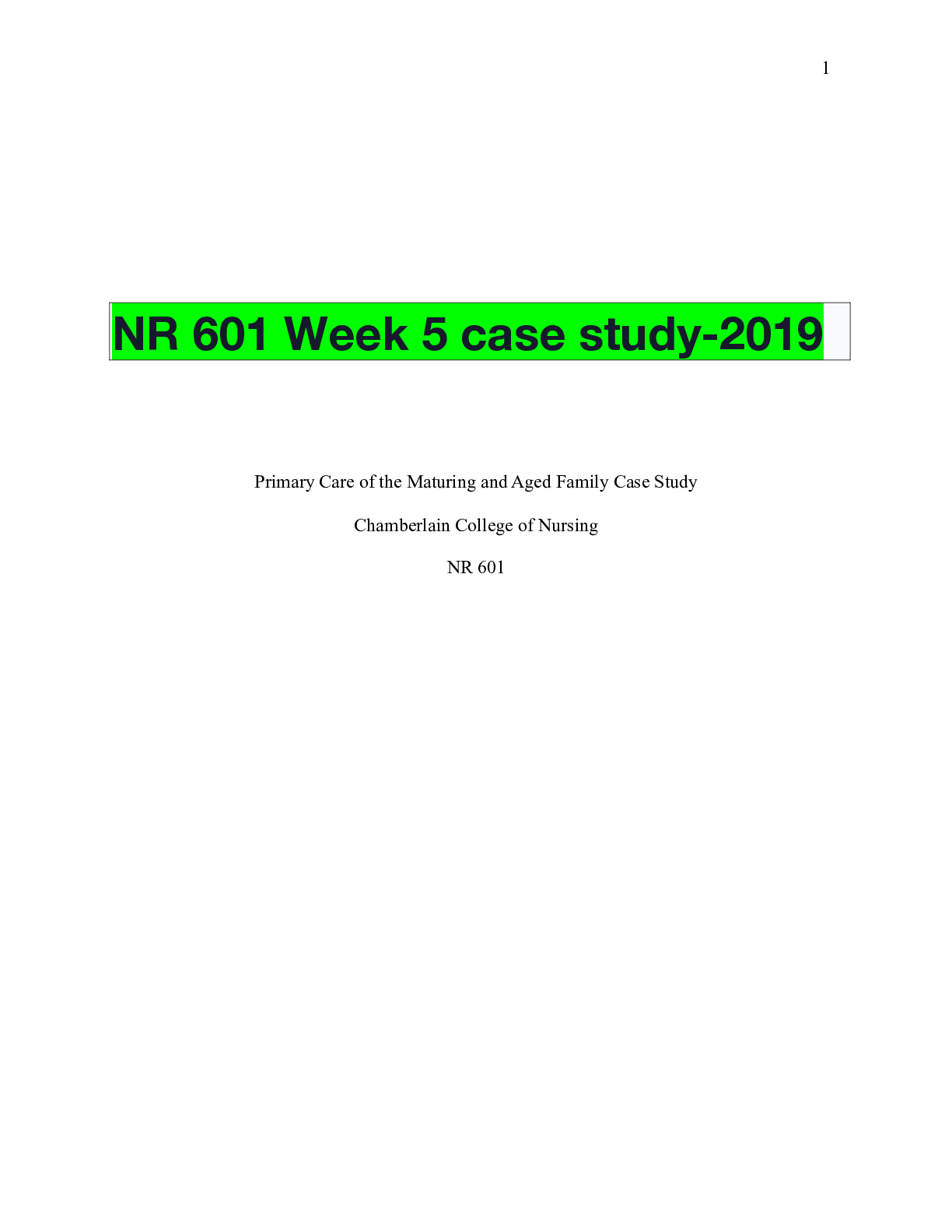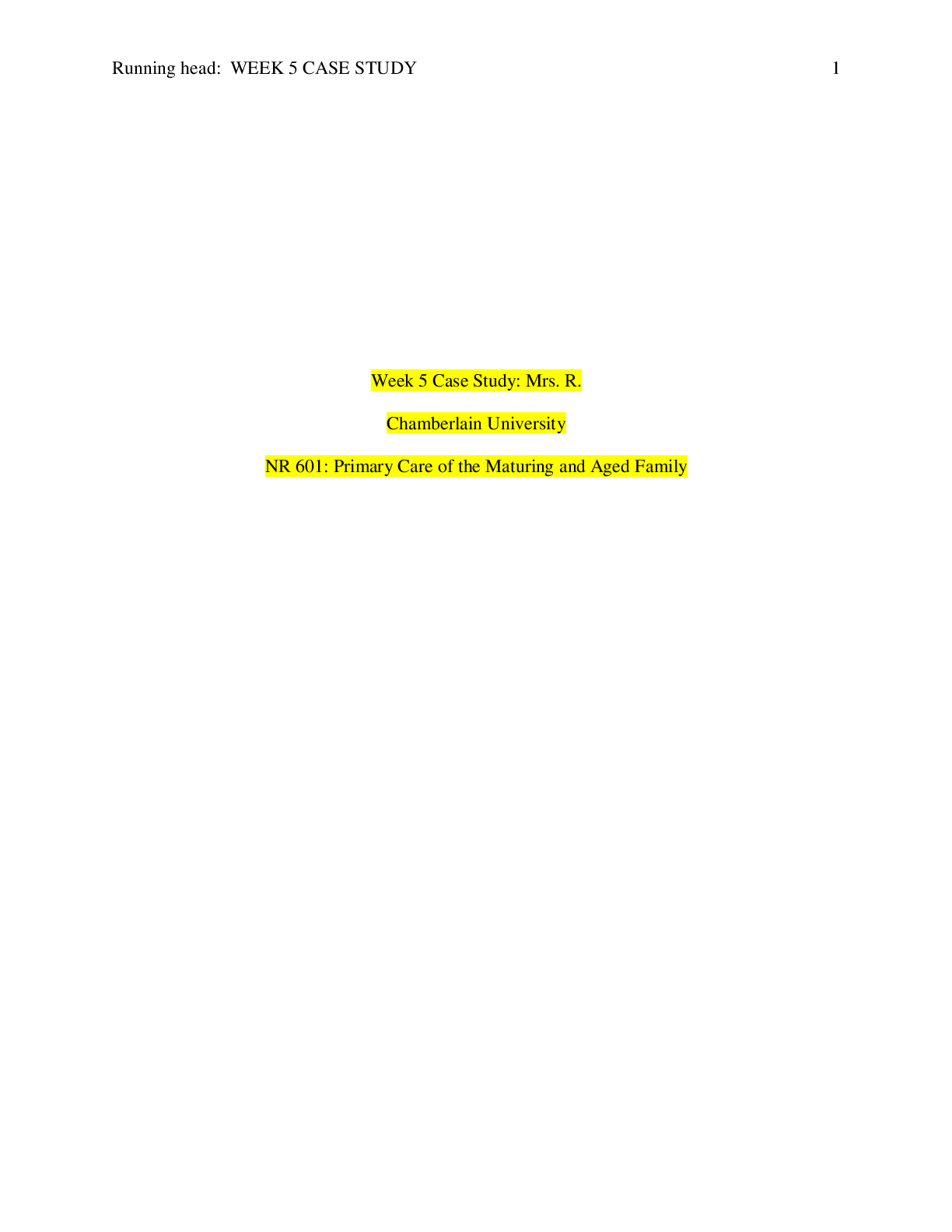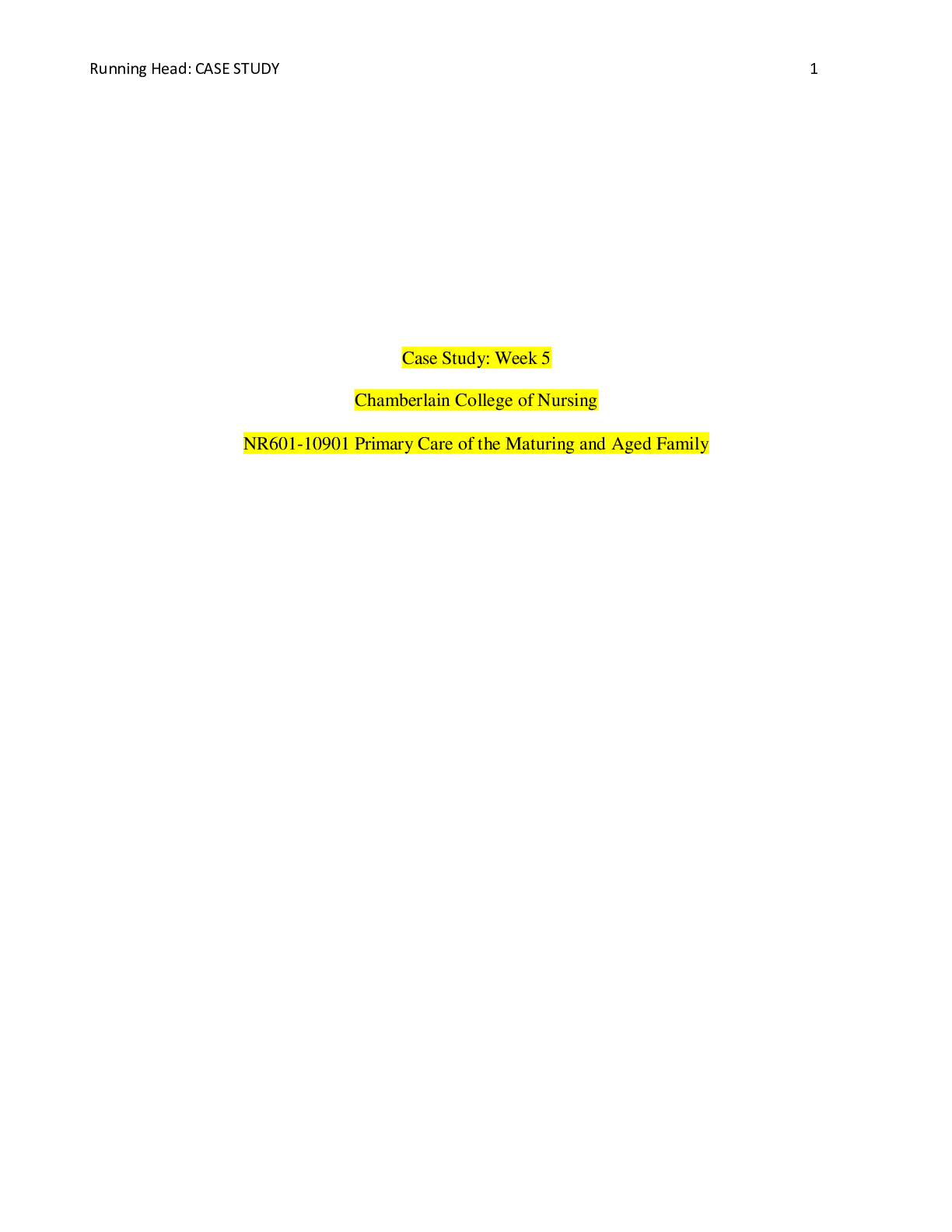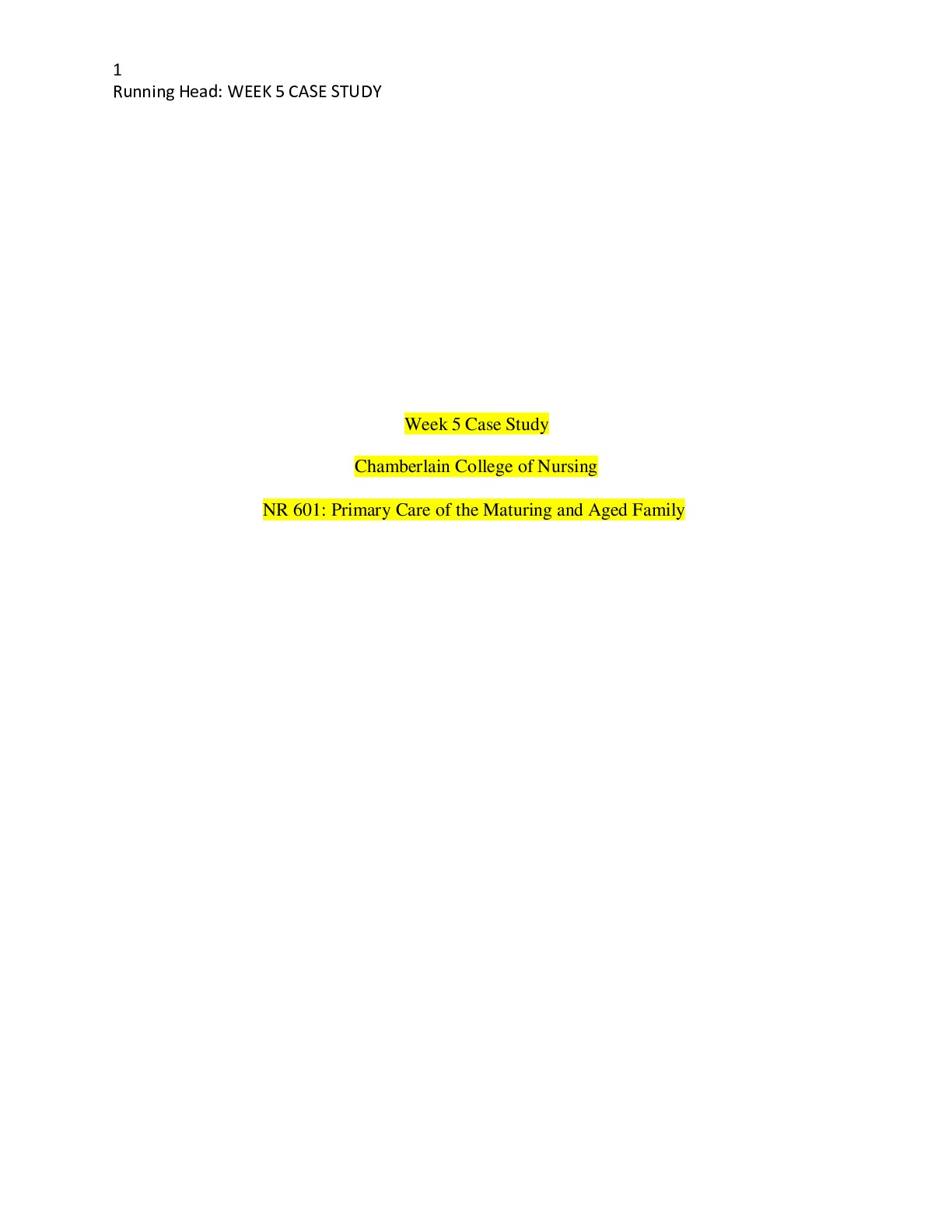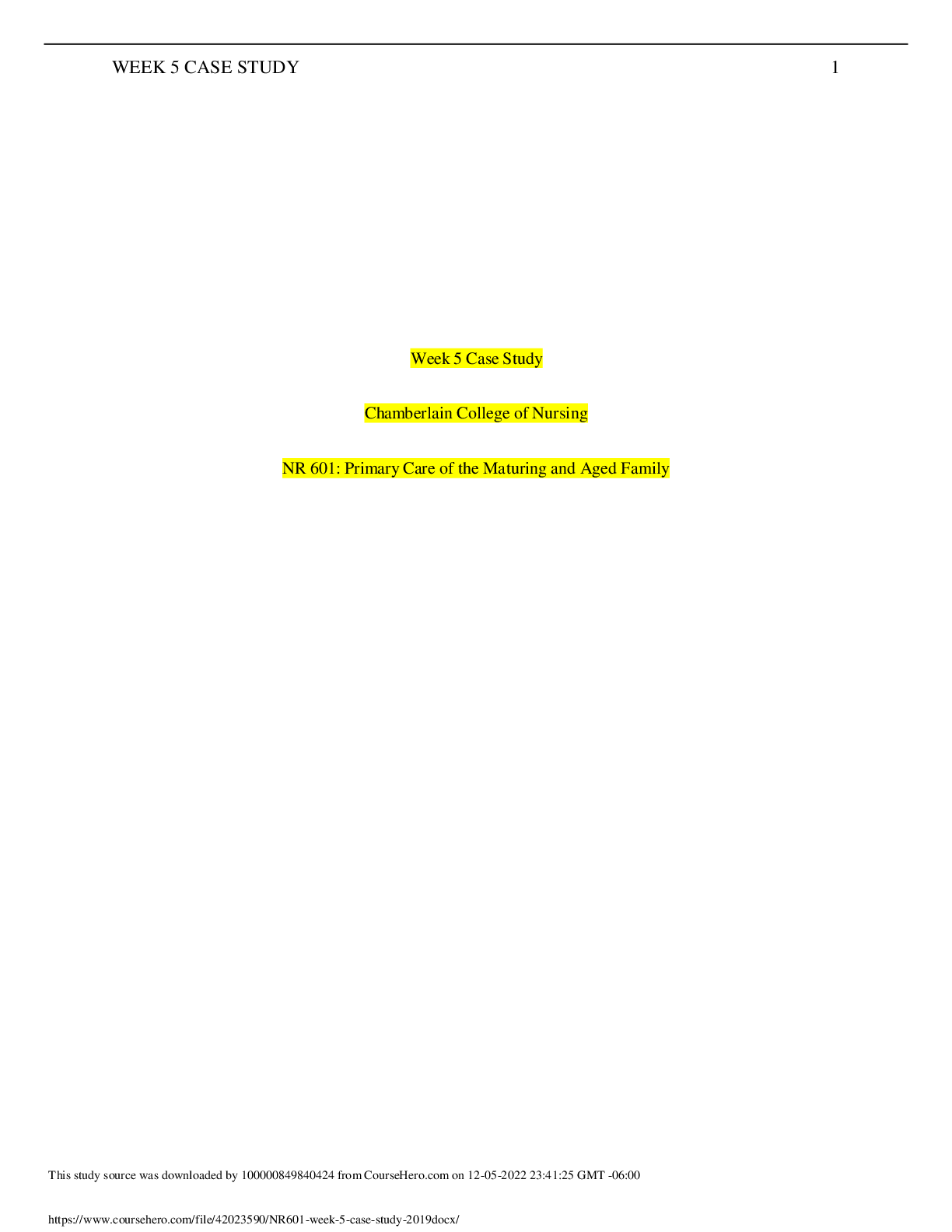Project Management > CASE STUDY > PROJ 587 Week 5 Case Study - Download Paper For A Pass (All)
PROJ 587 Week 5 Case Study - Download Paper For A Pass
Document Content and Description Below
Running Head: WEEK FIVE CASE STUDY PROJ 587 Week 5 Case Study Table of Contents Table of Contents 1 Executive Summary 2 Project Selection Criteria 3 1st phase 3 2nd phase... 4 Portfolio Application Process 6 Project Recommendations 7 Project ordering upgrade 7 Project Tableware 8 Project Rocky: 8 Time-Based Plan 9 Explanation of Projects Selected 9 Project Rocky 9 Project Ordering Upgrade 10 Project Tableware 10 Executive Summary Below is a list of the project selction criterias that are propposed for the calls that will be given within the framework of the company. It will be used to describe the methods that are used to select projects for the following fiscal year. The project will be based on transparency, traceability and the binding criteria. The ultimate goal is to increase transparency to make the decision making process much easier. The partners of the project will come up with different ideas and submit it to the project manager. Once all the submissions are received, they will all undergo a two-part procedure evaluation. The project managers will oversee this process and the selection criteria will be based on the criteria’s outlined here. INTERNAL MEMO The company has six different proposed projects called Project Europa, Project Rocky, Project call center, Project ordering upgrade, Project robot and Project tableware. Only certain project proposals are forwarded to the SBU and only certain ones are viable enough to reach the company goals within the time set for the whole company. The proposals that are sent are structured to use the absolute least amount of money and still achieve desirable results. Customer service is very important in the hospitality industry and must be taken very seriously. Customer feedback is crucial for growth and expansion which is based on customer satisfaction. Happy customers and timely delivery of services is optimal in order to achieve this goal. The company strongly needs selection criteria’s for the projects to make sure that they stay in line with their budget, vision, and strategy. Project Selection Criteria Due to the limits of the budget allocated by the company, the SBU will have to choose projects that will not be expensive but will meet the desired outcomes. The project selection criteria below is proposed for the calls that will be given in the framework of the company. It will be used to help describe the procedure to select projects to have. The selection of the proposal will be based on transparency, traceability, time, projected revenue generation, and binding criteria. The goal is to help make the decision making process much easier to approve. The partners for the project will come up with a proposal which will then be submitted to the project manager. Once all submissions are made, they will then be taken through a two-phase procedure of evaluation. This will then be carried out by the project managers and will be based on the selection criteria. 1st phase During the first phase, projects will go through different check marks to determine whether they comply with the administration and the eligibility criteria. This is done to ensure that they are all fulfilling the administrative terms that the company requires to achieve its goals and revenues. The procedure will go through an on/off method and the projects that do not fulfill and meet the requirements of the company will not qualify for the second phase. This is because the second phase of the criteria takes on advanced evaluations of the projects proposed. Failing the first phase means that the project cannot pass the second phase. 2nd phase Quality evaluation is used in this assessment which is very important. All the projects that passed the first phase will now be subjected to this quality assessment. The assessment will be based on a scoring system. This part of the assessment deals with eligibility and eligibility criteria will help determine whether the proposals are up to the requirements to be funded by the company. The project should be able to build more income for the company and the eligibility requirement helps with that decision. Eligibility criteria are not subject of interpretation but they could be answered with a simple yes or no. All the proposals that do not fulfill the criteria will be identified and will be rejected. The core selection criteria is used to check for quality and will entail the evaluation of the nature of the proposed project, its cost, contribution to the ultimate expansion goal, its timeframe, and the results its likely to bring, ease of management during expansion and the methodology of its evaluation proposed. The core selection criteria are divided into two: Content related criteria. This checks on the relevance of the project proposal, and the quality of the results expected. Implementation of related criteria. This criterion checks on the quality of management, methodological approach quality and its funding and budget. The value of the project is determined by the current value of the project summed to the amount of interest earned on the investment amount. If the current value is higher, it shows that the project is viable. Another tool involves the estimation of the rate of returns by the use of the gain of the investment value and the cost of investing in the project. The rate of returns is high, the organization is therefore growing. For some score criteria, the projects are given scores based on its priority. The highest scoring project gets to be chosen, this model is the easiest to use and it measures both quantitative and qualitative measures. This will be taken from a list of all the projects that have passed the first phase. The process will be carried out by the project managers in the project evaluation. Another criterion is the cost-benefit analysis. It is used to control the cost to be used in the selected projects. It involves screening of all the pros and cons of a project and then eliminating the cons. The main consideration when using this process is whether the cost control can be done when undertaking the project. The criteria detailed here is long, and it may take time to go through all the project proposals put through to the selection board. In this specific SBU, rigorous scrutiny process will have to be taken on the forwarded proposals to ensure that the desired growth is attained. There has not been a good portfolio management process in the SBU, so all the projects that are already in action are not bringing in the desired results. This SBU being the department of the company that helps in service delivery, all projects passed by the criteria has to be aimed at providing the best customer experience and the utmost customer satisfaction. This will be a huge boost towards the desired expansion of the company. Portfolio Application Process Since we are trying to choose the best project that is tailor-made for the company’s budget, aim and timeframe, the projects have to go through a thourough scrutiny process using the selection criteria given. This is essential to ensure projects that do not add any value are rejected. They also need to be scrutinized to make sure that any ongoing projects that are using too much of the budget and other resources are canceled or downscaled. These methods of selection will make sure that the best and cost-effective projects are selected and started immediately. This will also help them determine which projects they can run simultaneously. After going through the selection criteria, the projects that without a doubt satisfy the company’s objectives and attain the highest scores on the scorecard are chosen to run. According to the scorecard, after the projects went through the project selection criteria, all the six projects scored differently and thus made it easier to choose the three best ones to fit the company. The scorecard results are: Projects Criteria Score Increase Budget/ Reduce Customer Expansio Expansion revenue time operating, satisfactio n of to a new overhead n services market and warehouse cost Order Processing YES YES YES YES YES NO 5 Rocky YES YES NO NO YES YES 4 Europa YES YES NO NO YES YES 4 Robot YES NO YES NO NO NO 2 Tableware YES NO YES NO NO NO 2 Call center NO YES NO YES YES NO 3 Table 1: Project selection criteria scorecard According to the scorecard, after all the six projects passed through the selection criteria, the projects Rocky and Ordering upgrade came on top with the highest scores. These projects are friendly to the budget allocated to the SBU. Based off the company’s goals of expanding, increasing their annual revenue and reduction of operations, the two projects fully satisfy the needs. Their timelines and recommendations are the best for the goals the SBU has set. Project Recommendations The projects that are recommended are Project Ordering Upgrade, Project Tableware, and Project Rocky. All projects will be divided into 4 quarters for the year and has the total budget of $ 24 million which will be allocated accordingly. This means total spending budget for each quarter will be about $6 million. Project ordering upgrade: Purpose of the project: Upgrade the company’s online ordering system to a state of the art system. • Initial Cost: $2.5 Million • Quarter Cost: $2.5 Million (1st Quarter) • Additional Costs: Cost of total operating expenses for two to three days. Reduction in operating expenses by $245,000 a year due to a reduction in staff by 7 employees at $35,000 year for labor. • Expected payback period: Due to this project being a service upgrade it has no payback period. However, the upgrade will reduce operating expenses by cutting down the workforce as well as increase the customer satisfaction. Project Tableware: Project Purpose: Expand current business to supply tableware to the cruise industry • NPV: $1 million over 5 years • Initial Costs: $5.5 million (spread out over 2 quarters) • Additional costs: $300,000 Yearly operating expenses • Expected payback period: 4 years Project Rocky: Project Purpose: Expand into the Alaskan Cruise ship market increasing market share by entering new area of operations as well as provide a better service to our current and prospective customers. • NPV: $19 million over 5 years. • Initial Cost: $13 Million Dollars • Quarter Cost: $2.75 Million Dollars (spread out through 4 quarters) • Additional Cost: $400,000 Dollars/ year • Expected payback period: 2-3 years. Time-Based Plan The time-based plan determines the expenses that are given to each project and the distribution for each quarter. The table below gives an outline of the funds allocated to the projects in each fiscal quarter of the year. Total spending for the year will sum up to $ 22.45 million. Project Name 1st Quarter 2nd Quarter 3rd Quarter 4th Quarter Ordering upgrade $ 2.5 million Rocky $ 3.25 million $ 3 million $ 3 million $ 3.75 million Tableware $ 2.75 million $ 2.75 million Rocky Operating cost $ 400,000 Tableware Operating cost $ 300,000 Ordering Upgrade Labor cost $ 70,000 $ 70,000 $ 70,000 $ 70,000 Contingency funds $ 180,000 $ 180,000 $ 180,000 $ 1.48 million Total: $ 6 million $ 6 million $ 6 million $ 4.45 million Table 2: Quarterly Budget Allocation Explanation of Projects Selected Project Rocky Project Rocky allows the company the opportunity of expansion into the Alaskan market. The project also presents a two – three year turn around rate. This will be more than enough time for the company to recover the $13 million they will initially use to set up the expansion. The project is estimated to bring in $19 million in about five years from the start date. This is a very great NPV. The project brings up a huge challenge for management but if the team work well together, the company will be at an advantage. Since this is an entirely new market, the company’s first goal will be creating a good rapport with the people of Alaska. Workers will have to be outsourced and all of this will have to happen as quick as possible so that the company can achieve its goals to increase its revenue and maintain the expansion. Project Ordering Upgrade Ordering from the company is done online but the operating systems are about decade old which makes the process slower. Upgrading the ordering systems will ensure that a state of the art system is put in place and that customers will have less issues ordering online. This upgrade will also bring a reduction of 50% of the order processing thus giving the workers more time to produce more orders. This will also cause a reduction in the employees by almost half in numbers, from a total of 15 to 8 employees. This will help the company cut costs on wages as well as staff, which is among the goals the company wants to achieve. The payback period in reduced labor costs alone is 10 years. Kickstarting the project will just cost the company two and a half million dollars and two to three days of operating expenses due to the system being down. The workforce will be internal thus the company will not incur any more costs. Project Tableware This project helps the company by expanding the current business into supplying tableware to the cruise industry. There will be little resistance to entry due to the current market being supplied by some smaller companies that we could easily compete with. The entry to market in tableware will cost $ 2.75 million over the 2nd and 3rd quarters with an expected payback period. The short-term payback for the investment in this project is minimal due to a 4- year payback period. However, this would enable the company to become a one-stop shop for the Cruise ship industry for tableware as well as linens, and this will create better customer satisfaction which aligns with the company goals. Please let me know if there are any questions or concerns with what I have proposed. Best regards, Portfolio Manager [Show More]
Last updated: 11 months ago
Preview 1 out of 12 pages
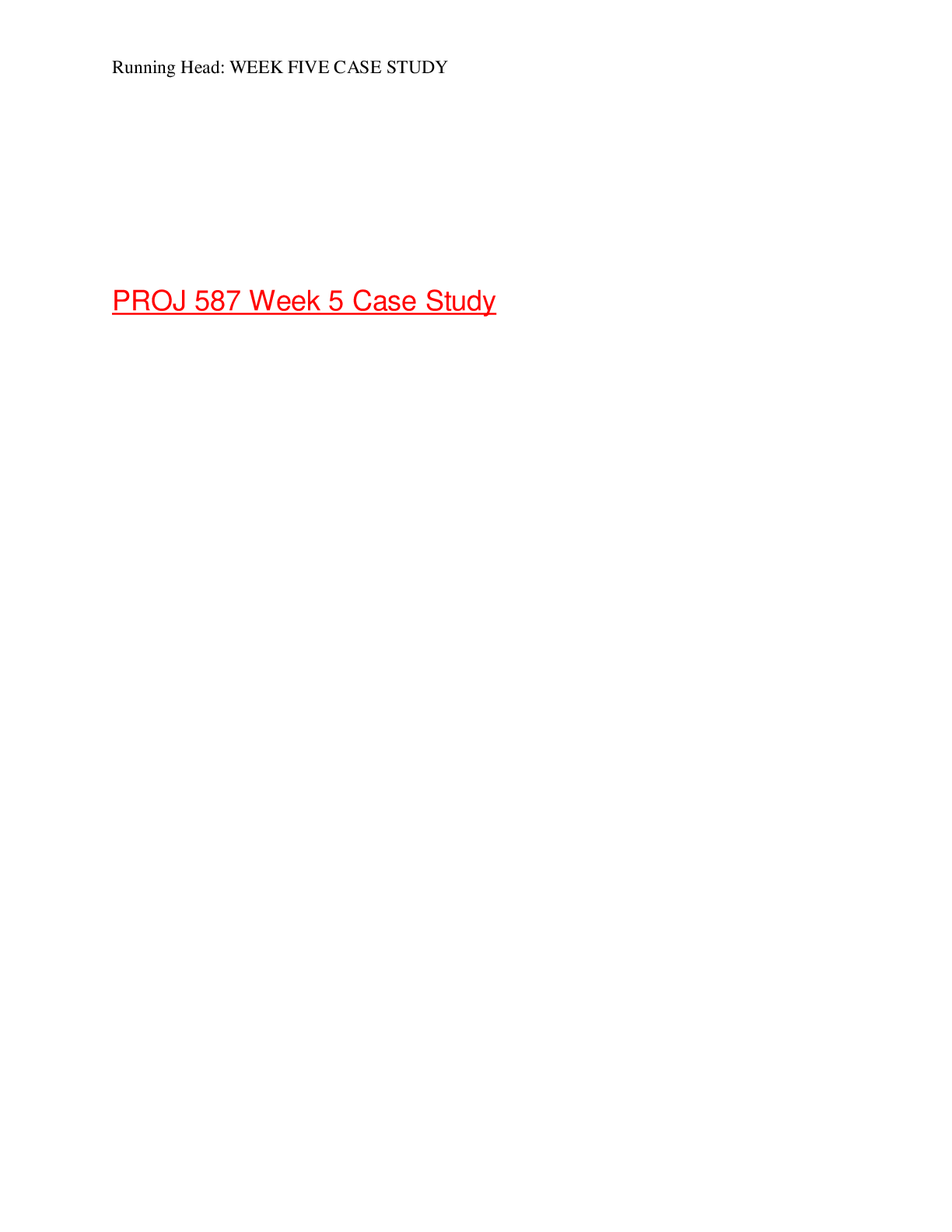
Reviews( 0 )
Document information
Connected school, study & course
About the document
Uploaded On
Jun 02, 2023
Number of pages
12
Written in
Additional information
This document has been written for:
Uploaded
Jun 02, 2023
Downloads
0
Views
45


